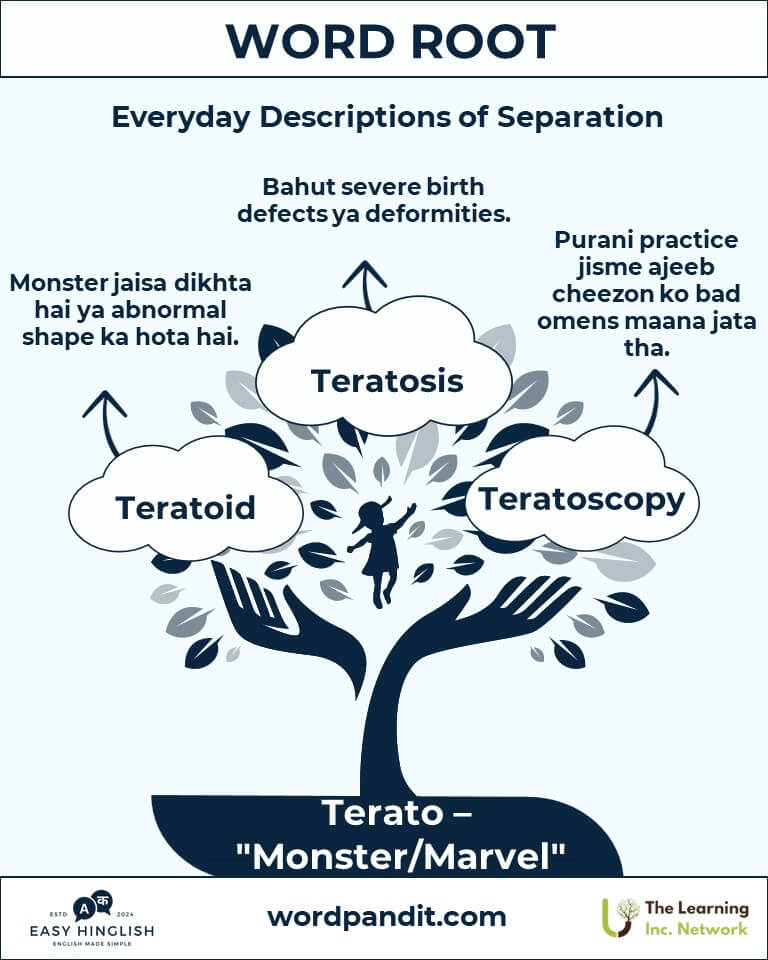Terato: The Monstrous Root of Anomalies in Science and Medicine
(Terato: Vaigyanik aur Chikitsa ke Anomalies ka Mool - वैज्ञानिक और चिकित्सा के असमानताओं का मूल)
Discover the fascinating origin and applications of the root "Terato," derived from the Greek word for "monster" (राक्षस). This root helps in understanding anomalies and marvels in biology and medicine.

Table of Contents
- Introduction: The Essence of Terato
- Etymology and Historical Journey
- Mnemonic: Unlocking the Power of Terato
- Common Terato-Related Terms
- Terato Through Time
- Terato in Specialized Fields
- Illustrative Story: Terato in Action
- Cultural Significance of Terato
- The Terato Family Tree
- FAQs About the Terato Root
- Test Your Knowledge: Terato Mastery Quiz
- Conclusion: The Living Legacy of Terato
Introduction: The Essence of Terato
(Terato ka Mool Arth - Terato का मूल अर्थ)
The root "Terato" means "monster" (राक्षस) or "marvel" (चमत्कार). Initially, it was used for mythical creatures and extraordinary phenomena, but now it is used in medicine and biology to describe anomalies (असमानताओं).
Example Words: Teratology (study of congenital malformations) and teratogen (agents that cause developmental anomalies).

Etymology and Historical Journey
(Terato ki Utpatti aur Itihas - Terato की उत्पत्ति और इतिहास)
The word "Terato" originates from the Greek word "teras," meaning "monster" (राक्षस) or "omen" (शगुन).
- Ancient Use: Used for myths and portents.
- Renaissance Period: Medical scholars started systematic studies on congenital anomalies (जन्मजात असमानताओं).
- 19th Century: Terato became a core concept in embryology and pathology.
Mnemonic: Unlocking the Power of Terato
(Mnemonic ke Zariye Terato ko Yaad Rakhein - Terato को याद रखने का तरीका)
Imagine a mythical beast standing at the entrance of a library. This symbolizes anomalies and rare phenomena.
Mnemonic Device: "Terato reveals the marvels and monsters of biological anomalies."
Common Terato-Related Terms
(Terato-se Jude Common Shabdon ka Arth - Terato से जुड़े आम शब्द और उनके अर्थ)
- Teratology (teh-rah-tol-uh-jee): The study of congenital abnormalities.
Example: "Advancements in teratology have made birth defect prevention easier." - Teratogen (teh-rah-toh-jen): Agents that cause malformations in embryos.
Example: "Thalidomide became a harmful teratogen during pregnancy." - Teratoid (teh-rah-toid): Abnormal growth resembling a monster-like form.
Example: "The tumor's teratoid structure contained multiple tissues." - Teratosis (teh-rah-toh-sis): A condition involving congenital malformations.
Example: "Cases of teratosis in neonates are quite rare." - Teratoma (teh-rah-toh-mah): A tumor containing an unusual combination of tissues.
Example: "Doctors successfully removed a teratoma from the patient's abdomen."
Terato Through Time
(Samay ke Saath Terato ka Safar - समय के साथ Terato का सफर)
- Teratoscopy (Historical):
- In ancient superstition, anomalies were considered bad omens.
- Modern science replaced this idea by introducing evidence-based teratology.
- Teratogen Identification (Modern):
- In the 20th century, research identified harmful substances like thalidomide.
- Public health policies and prenatal care underwent a revolution.
Terato in Specialized Fields
(Vishesh Kshetron mein Terato ka Upyog - विशिष्ट क्षेत्रों में Terato का उपयोग)
- Medicine:
Teratology helps in understanding and preventing congenital disabilities.
Example: Identifying environmental teratogens to reduce pregnancy risks. - Pharmacology:
Teratogen research guides drug safety regulations.
Example: Banning harmful medications during pregnancy. - Oncology:
Teratomas present challenges for surgeons and researchers.
Example: Advanced imaging techniques help in diagnosing teratomas.
Illustrative Story: Terato in Action
(Ek Kahani jo Terato ka Mahatva Dikhati Hai - एक कहानी जो Terato का महत्व दिखाती है)
Dr. Elena Vasquez, a renowned teratologist, encountered a rare case of teratosis. Her research led to the discovery that contaminated water was acting as an unidentified teratogen. This breakthrough led to a community-wide action plan that prevented future cases, showcasing the vital role of teratology in public health.
Cultural Significance of Terato
(Terato ka Sanskritik Mahatva - Terato का सांस्कृतिक महत्व)
The concept of "monsters" exists across all cultures—from Greek mythology’s hydras to modern scientific anomalies. Terato embodies a mix of fear and wonder, bridging ancient superstitions with modern scientific understanding.

The Terato Family Tree
(Terato Family ke Related Words - Terato परिवार के संबंधित शब्द)
- Morph- (Shape, form - आकार): Example: Morphology – The study of form and structure.
- Gen- (Origin, birth - उत्पत्ति): Example: Genetics – The study of heredity and variation.
- Patho- (Disease - रोग): Example: Pathology – The systematic study of diseases.

FAQs About the Terato Word Root
(Terato Root se Jude Prashn aur Uttar - Terato से जुड़े सवाल और जवाब)
Q: "Terato" ka kya matlab hai aur yeh kahaan se aaya hai?
A: "Terato" ka matlab hai "monster" (राक्षस) ya "marvel" (चमत्कार). Yeh Greek word teras se derived hai jo pehle mythical creatures aur extraordinary phenomena ko describe karta tha. Modern usage mein, yeh anomalies aur abnormalities ke liye use hota hai, khaaskar biology aur medicine mein.
Q: Teratology kya hai aur yeh kyun zaruri hai?
A: Teratology congenital abnormalities (जन्मजात असमानताएं) aur malformations ka study hai. Yeh genetic, environmental, aur chemical factors ka embryonic development par impact samajhne ke liye important hai. Yeh prenatal care aur birth defect prevention mein madad karta hai.
Q: Teratogen kya hota hai aur yeh development par kaise asar karta hai?
A: Teratogen ek aise substance ya environmental factor ko kehte hain jo embryonic development (भ्रूण विकास) ko disrupt karta hai aur malformations cause karta hai. Examples: Certain drugs (जैसे थैलिडोमाइड), alcohol, aur rubella jaisi infections.
Q: Teratoma kya hai aur yeh significant kyun hai?
A: Teratoma ek aisa tumor hota hai jo tissues ya organs (जैसे बाल, दांत, या मांसपेशी) contain karta hai jo uski location ke liye typical nahi hote. Yeh pluripotent cells se banta hai aur cellular differentiation aur embryonic processes ko samajhne mein madad karta hai.
Q: Congenital anomaly aur teratoid condition mein kya farak hai?
A:
• Congenital anomaly: Koi bhi abnormality jo birth ke time par present ho, jaise cleft palate ya heart defects.
• Teratoid condition: Monster-like ya multi-tissue abnormalities, jaise teratomas.
Test Your Knowledge:Terato Mastery Quiz
(Terato Quiz ke Zariye Apne Gyaan ko Test Karein - Terato क्विज़)
1. "Terato" root ka matlab kya hota hai?
2. Teratology kis cheez ka study karta hai?
3. Kaunsa example ek teratogen ka hai?
4. Teratoma kya hai?
5. Teratoscopy kya hai?
Conclusion: The Living Legacy of Terato
(Terato ki Jeevant Virasat - Terato की जीवंत विरासत)
The "Terato" root serves as a bridge between mythology and scientific exploration. What was once associated with superstition is now a crucial field in medicine, pharmacology, and oncology.
Key Takeaway: Terato inspires us to study biological complexities and uncover the scientific mechanisms behind anomalies. These anomalies are not just fearful mysteries—they are gateways to innovation and discovery.








